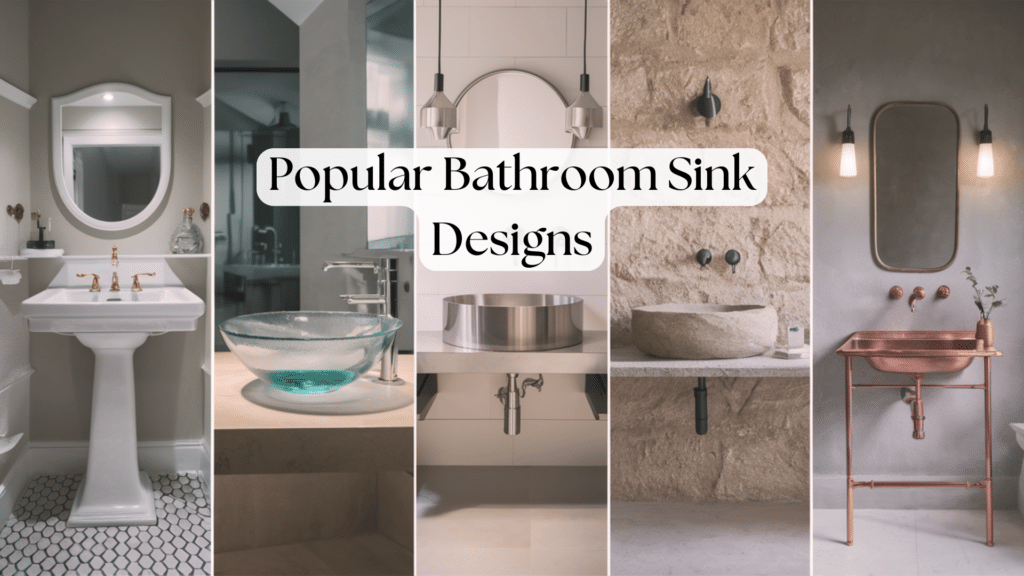Picking the right bathroom sink can make a big difference in how your bathroom looks and works. With so many options out there, finding the perfect match for your needs can feel overwhelming.
In this guide, I’ll walk through different bathroom sink types that fit various styles, spaces, and budgets. From wall-mounted options that save space to statement vessel sinks that catch the eye, I’ve got you covered.
I have spent years working with these fixtures and know what works best for different situations. I’ll help you understand:
- Which sinks work best in small bathrooms
- Options that are easier to clean and maintain
- Budget-friendly choices that still look great
By the end, you’ll have all the facts you need to choose a bathroom sink that you’ll enjoy for years to come.
Top Bathroom Sink Types for Every Budget
Looking to upgrade your bathroom? The sink is often the centerpiece that ties everything together. I’ve compiled different sink types to help you find the perfect match for your space.
Each option has its own unique style and functionality that might be just what you’re looking for.
1. Undermount Sink
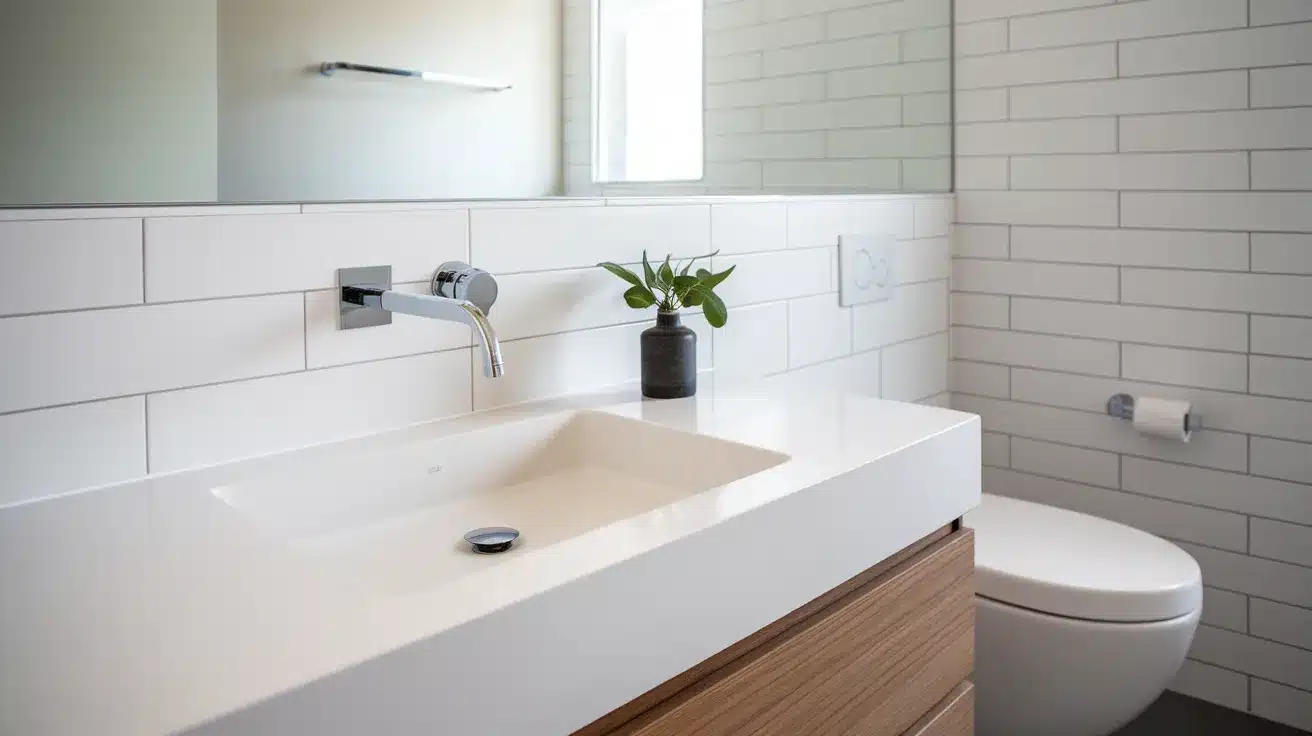
The undermount sink installs beneath your countertop, creating a seamless look with no rim or lip above the counter.
This design makes cleaning super easy—just wipe crumbs and water directly into the sink without any barrier. These sinks work best with solid countertop materials like granite, marble, or quartz.
| Pros | Cons |
|---|---|
| • Easy to clean | • More expensive installation |
| • Sleek, modern appearance | • Requires solid countertop material |
| • Maximizes counter space | • Cannot be used with laminate countertops |
| • Highlight beautiful countertops | • May need professional installation |
2. Drop-In Sink
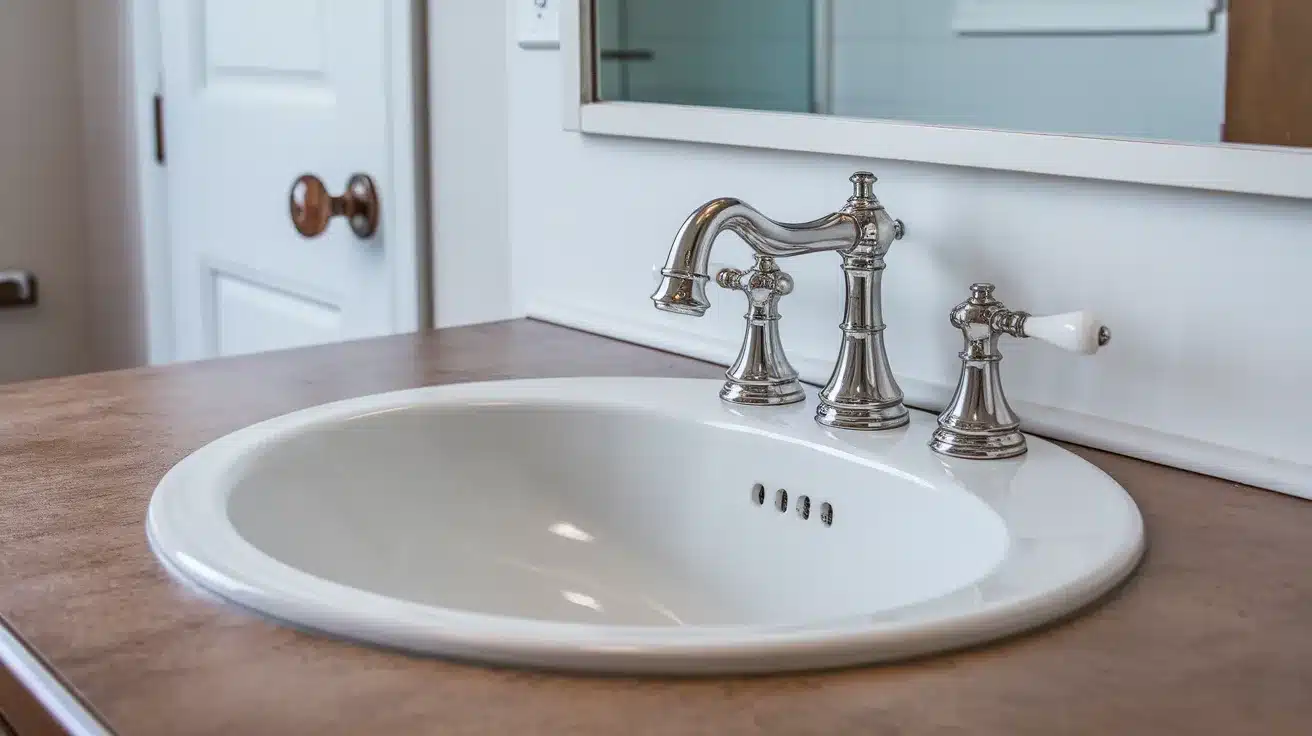
Drop-in sinks (also called self-rimming) have a visible rim that sits on top of the counter. You “drop” these sinks into a pre-cut hole.
They’re popular because they work with any countertop material and are very easy to install. The rim creates a finished edge that helps prevent water damage.
| Pros | Cons |
|---|---|
| • Easy DIY installation | • Rim collects dirt and grime |
| • Works with any countertop | • Less counter space |
| • Less expensive than undermount | • Not as sleek looking |
| • Prevents water damage to cabinet | • Harder to clean around edges |
3. Vessel Sink
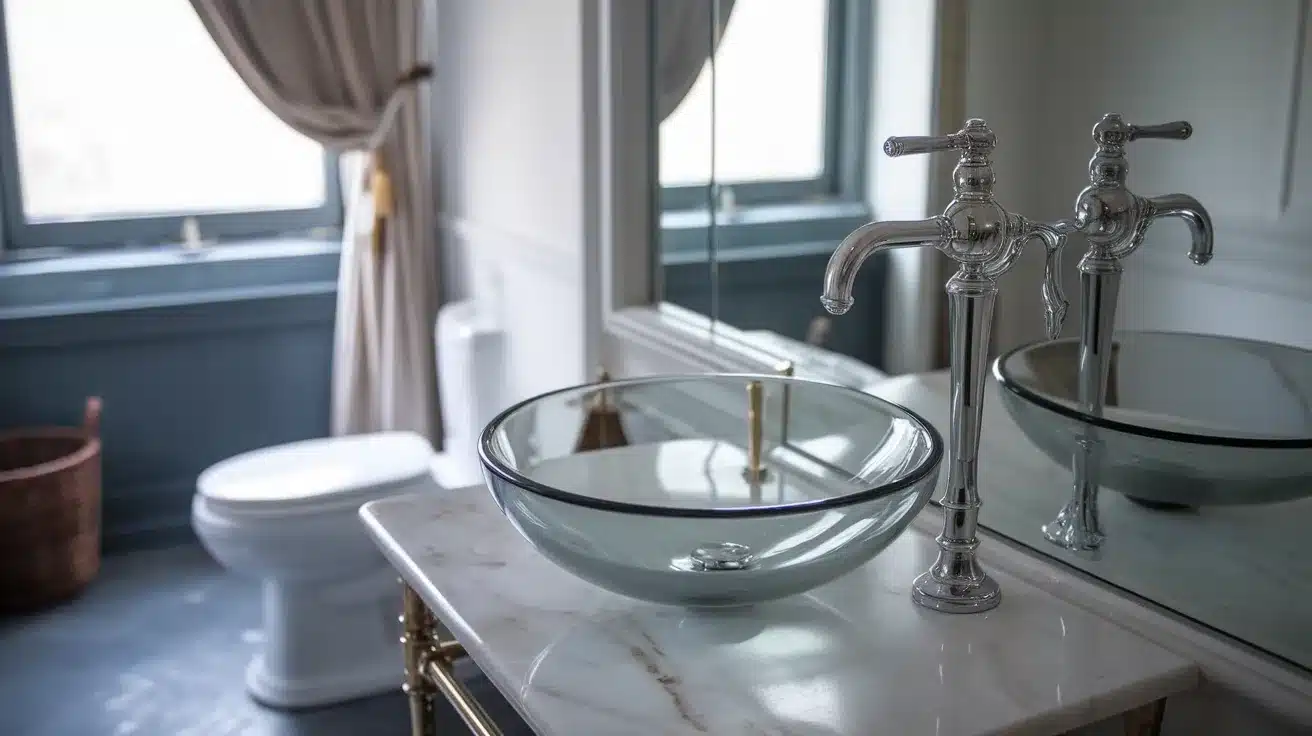
Vessel sinks sit completely on top of the counter like a bowl or vessel. They make a bold statement in any bathroom.
Originally inspired by washbasins from before indoor plumbing, these sinks now come in endless materials and designs—from glass to copper to stone. They typically require a special drain setup.
| Pros | Cons |
|---|---|
| • Eye-catching focal point | • Higher than standard sinks |
| • Many style options | • More difficult to clean around base |
| • Easy to replace or change | • Can splash more water |
| • Maximizes cabinet storage space | • Requires special faucet height |
4. Pedestal Sink
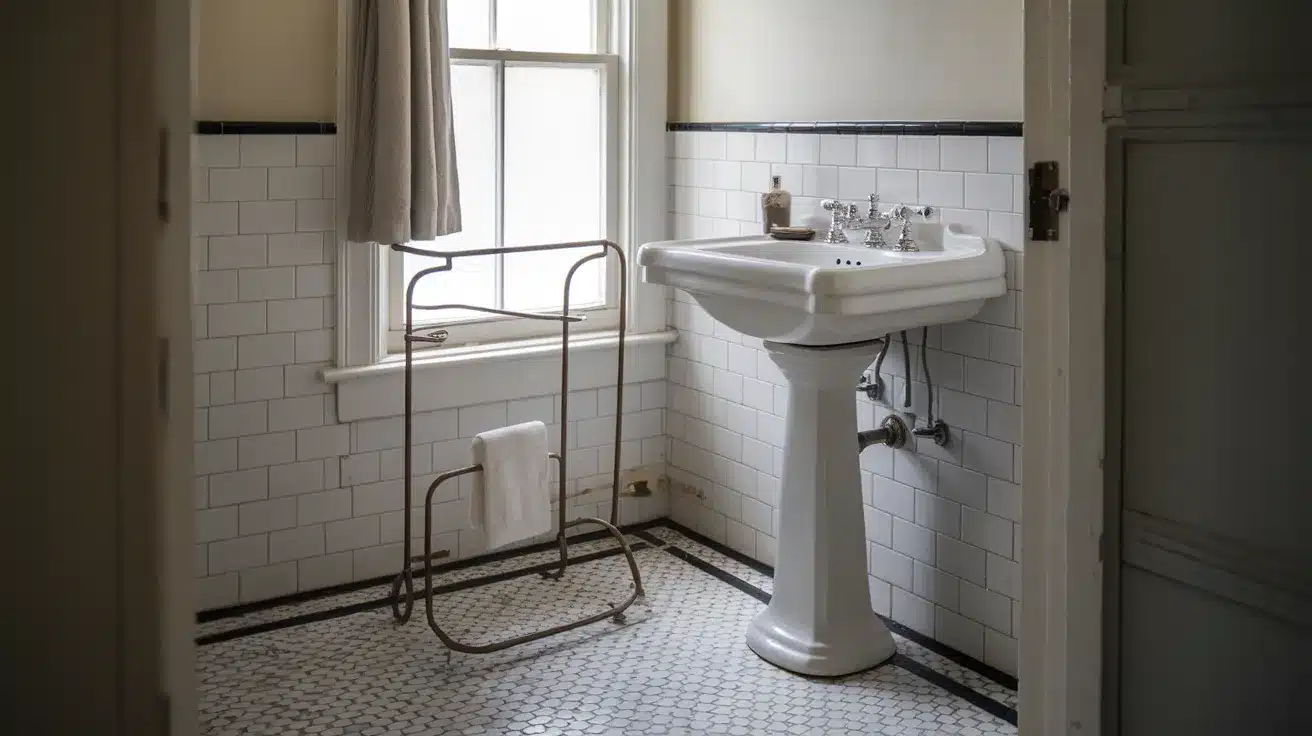
Pedestal sinks stand alone, with a basin supported by a column. They’re perfect for small bathrooms with limited space.
They do not have a counter or cabinet, creating an open, airy feeling. These classic sinks have been popular for over a century and work especially well in vintage or traditional bathrooms.
| Pros | Cons |
|---|---|
| • Perfect for small spaces | • No storage underneath |
| • Elegant, classic look | • Limited counter space |
| • Hide plumbing connections | • Less practical for family bathrooms |
| • Less expensive than vanity options | • Installation can be tricky |
5. Wall-Mounted Sink
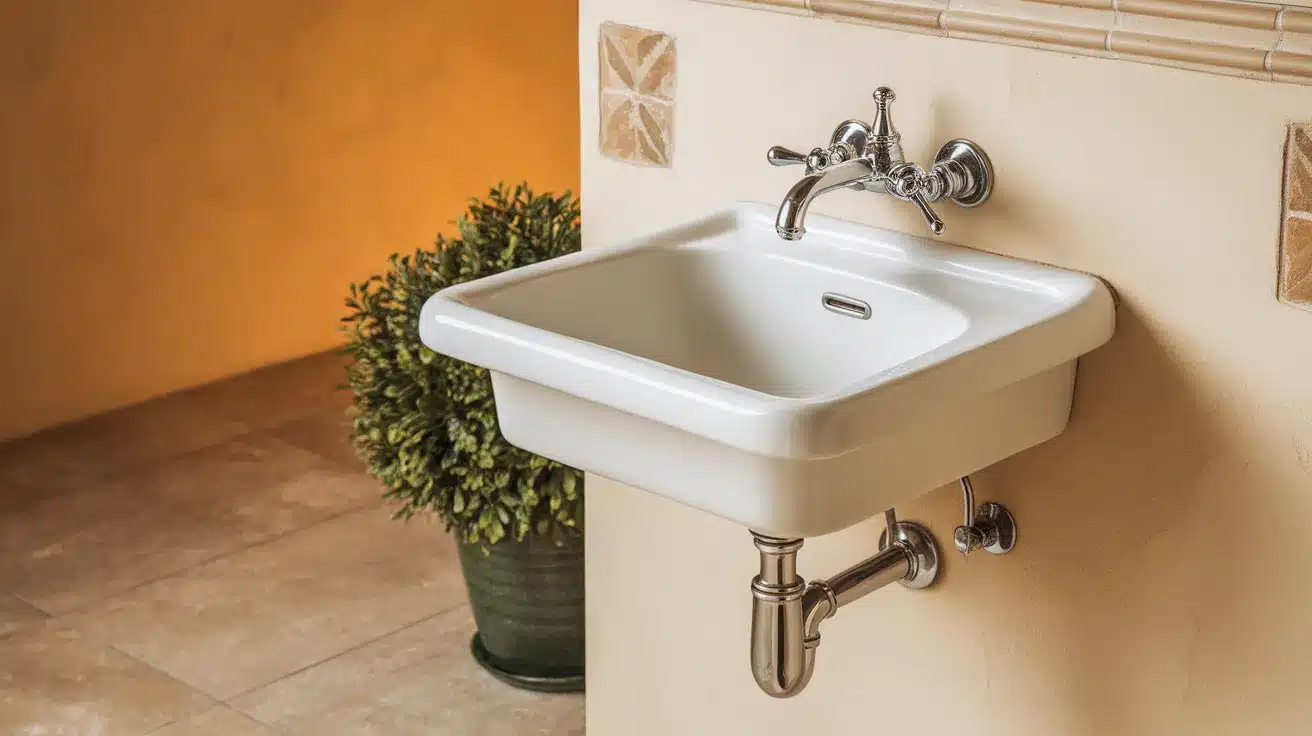
Wall-mounted sinks attach directly to the wall with no support underneath. This creates a floating effect that makes your bathroom feel bigger.
They’re great for minimalist designs and ADA-accessible bathrooms. The exposed plumbing can be hidden with a shroud or displayed as part of an industrial look.
| Pros | Cons |
|---|---|
| • Makes room look bigger | • Requires sturdy wall support |
| • Easier floor cleaning | • Exposed plumbing (unless covered) |
| • Adjustable height installation | • No storage space |
| • Good for wheelchair accessibility | • May look unfinished in large bathrooms |
6. Console Sink

Console sinks combine a wall-mounted sink with legs for extra support. They offer a bit of counter space while still maintaining an open feeling below.
Some models include a towel bar or small shelf for added functionality. These sinks blend vintage charm with practical design.
| Pros | Cons |
|---|---|
| • More counter space than pedestal | • Limited storage |
| • Elegant, furniture-like appearance | • More expensive than basic models |
| • Open, airy look | • Less privacy for plumbing |
| • Can incorporate towel bars | • Takes up more space than wall-mounted |
7. Corner Sink
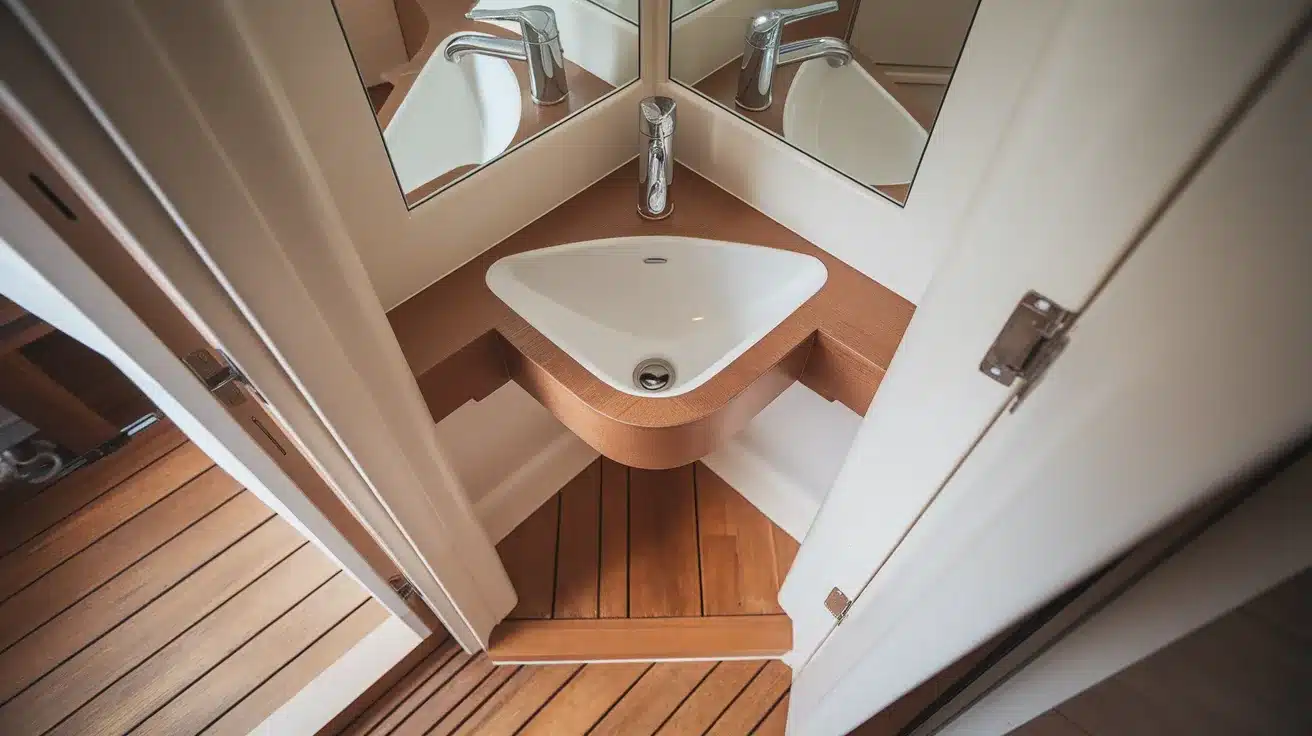
Corner sinks fit snugly into—you guessed it—the corner of your bathroom. They’re excellent space-savers in small powder rooms or awkward layouts.
These triangular or rounded sinks tuck away neatly while still providing functionality. They come in pedestal, wall-mounted, or cabinet versions.
| Pros | Cons |
|---|---|
| • Maximizes space in tiny bathrooms | • Usually smaller basin |
| • Works in awkward layouts | • Limited counter space |
| • Frees up wall space | • Harder to find replacement parts |
| • Can make the room feel larger | • Fewer style options |
8. Integrated Sink/Countertop
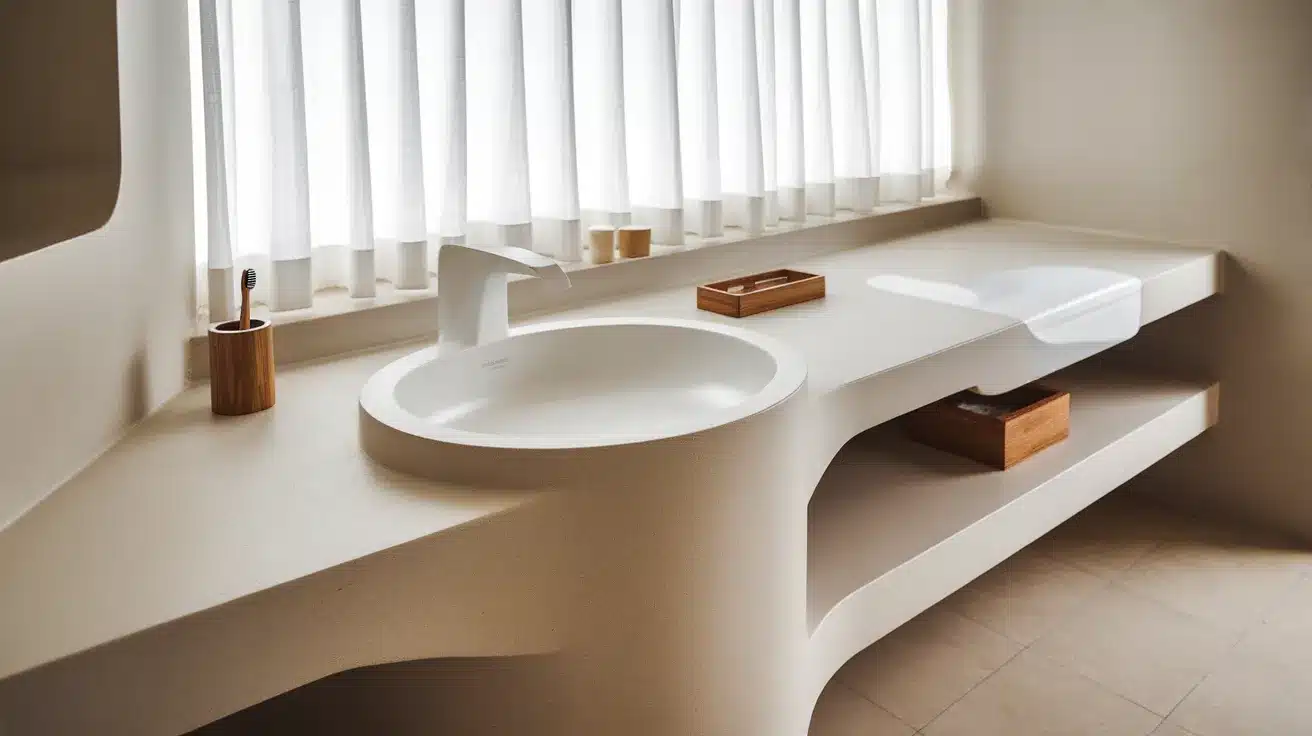
Integrated sinks form a single, seamless piece with the countertop. There are no seams, edges, or cracks to collect dirt.
This one-piece design can be made from materials like cultured marble, solid surface, or quartz. The sink and counter flow together for a sleek, modern look.
| Pros | Cons |
|---|---|
| • Extremely easy to clean | • Must replace entire unit if damaged |
| • No seams to collect dirt | • Limited color/material options |
| • Modern, seamless appearance | • More expensive than separate pieces |
| • Custom sizing possible | • Requires professional installation |
9. Semi-Recessed Sink
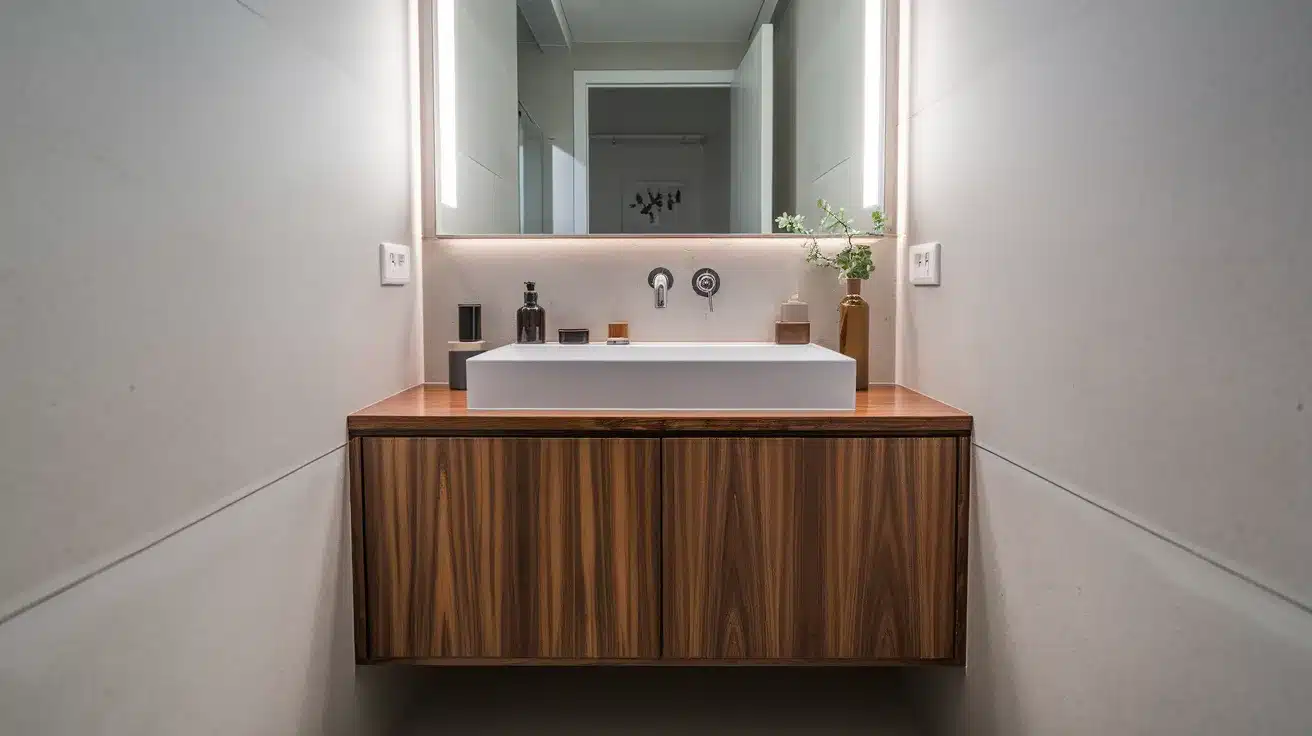
Semi-recessed sinks project partially forward from a shallow vanity. The front of the sink extends beyond the cabinet, making it easier to reach.
This design works well in bathrooms with limited depth while still providing some storage underneath. They’re a smart compromise between space-saving and functionality.
| Pros | Cons |
|---|---|
| • Works in narrow spaces | • Less common, harder to find |
| • Some storage underneath | • Limited styles available |
| • Good for wheelchair access | • Can look awkward in large bathrooms |
| • Easier to reach for children | • More water splashing possible |
10. Trough Sink
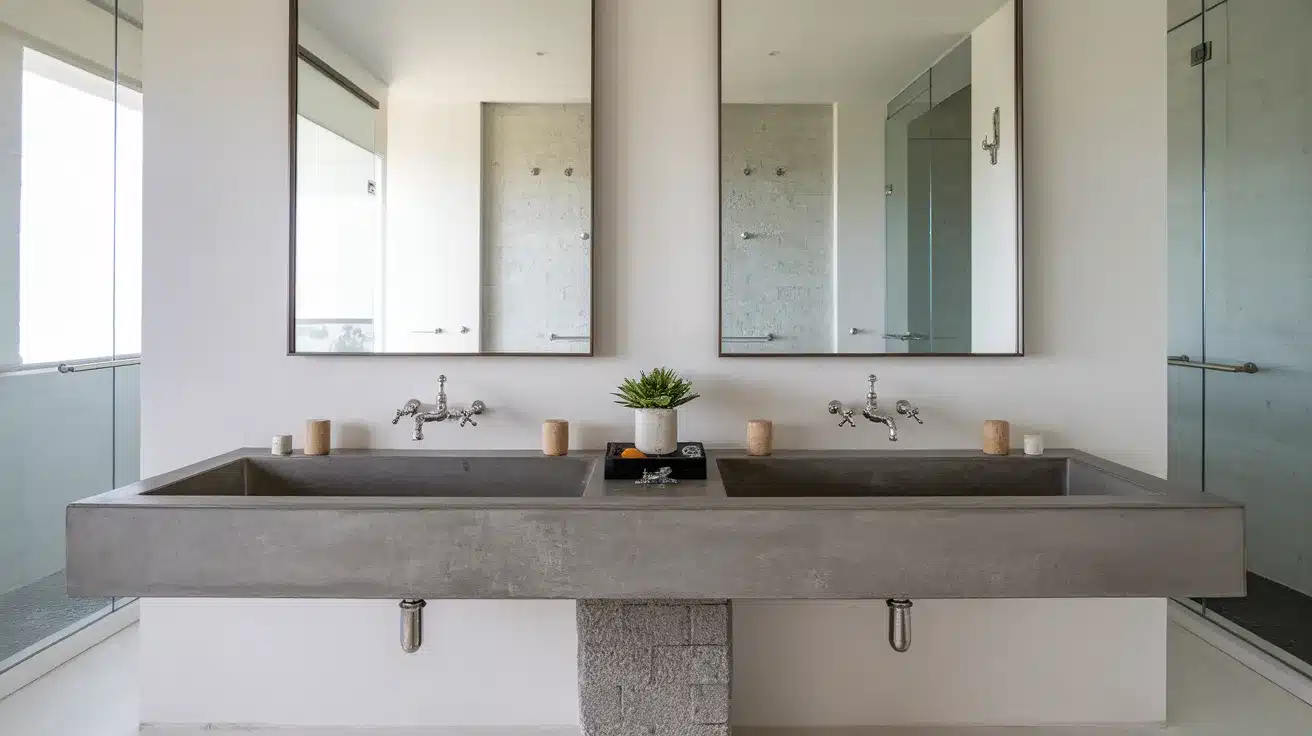
Trough sinks are long, narrow basins designed for multiple users. Perfect for kids’ bathrooms or master baths shared by couples.
These sinks come in various materials and can have one or multiple drains depending on the length. They bring a unique, almost industrial look to any bathroom.
| Pros | Cons |
|---|---|
| • Allows multiple users at once | • Takes up considerable wall space |
| • Makes a design statement | • May require custom plumbing |
| • Efficient use of space | • More expensive than standard sinks |
| • Fewer water splashes than double sinks | • Cleaning can be challenging in corners |
11. Copper Sink
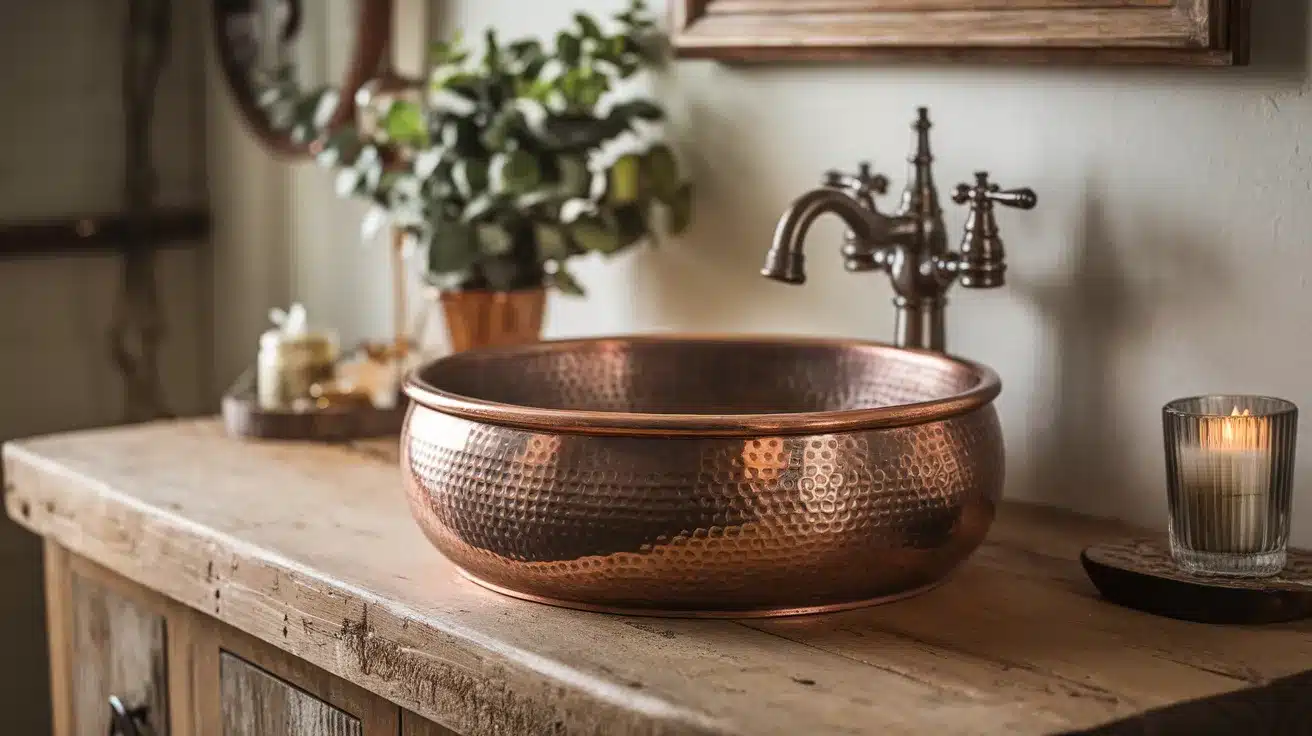
Copper sinks, with their rich, metallic glow, bring warmth and character to your bathroom. Over time, each one develops a unique patina that adds to its beauty.
Naturally antimicrobial, copper kills bacteria on contact—making these sinks both beautiful and practical. They come in various styles, from rustic to modern.
| Pros | Cons |
|---|---|
| • Naturally antibacterial | • Expensive compared to standard materials |
| • Develops a unique patina | • Requires special care and cleaning |
| • Extremely durable | • Can dent if heavy objects are dropped |
| • Each sink is unique | • May not match other fixtures |
12. Glass Sink
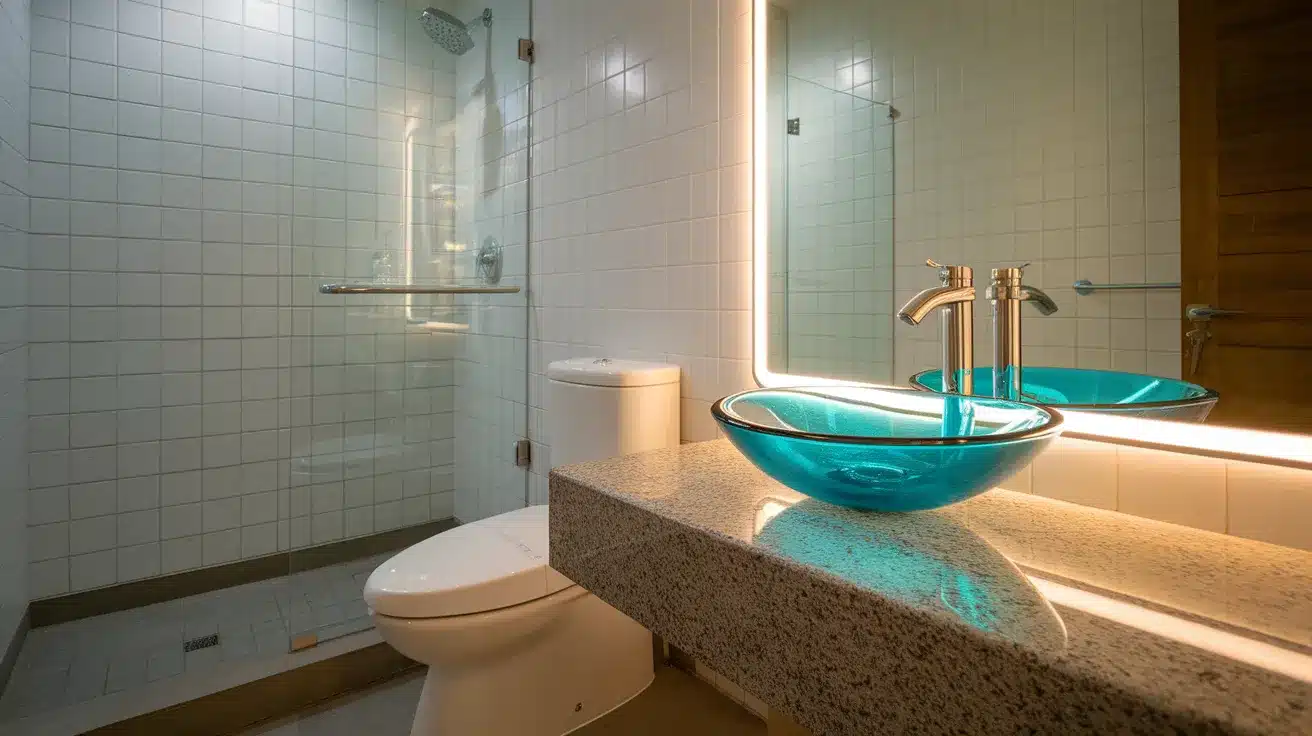
Glass sinks turn a functional fixture into a piece of art. Available in clear, frosted, or colored glass with various textures and patterns.
Light plays through these sinks in fascinating ways, especially when paired with proper lighting. They instantly elevate your bathroom’s style factor.
| Pros | Cons |
|---|---|
| • Stunning visual impact | • Shows water spots easily |
| • Wide variety of colors and styles | • Can chip or crack if hit hard |
| • Relatively easy to clean | • Typically more expensive |
| • Resistant to stains | • May require special installation |
13. Stone Sink
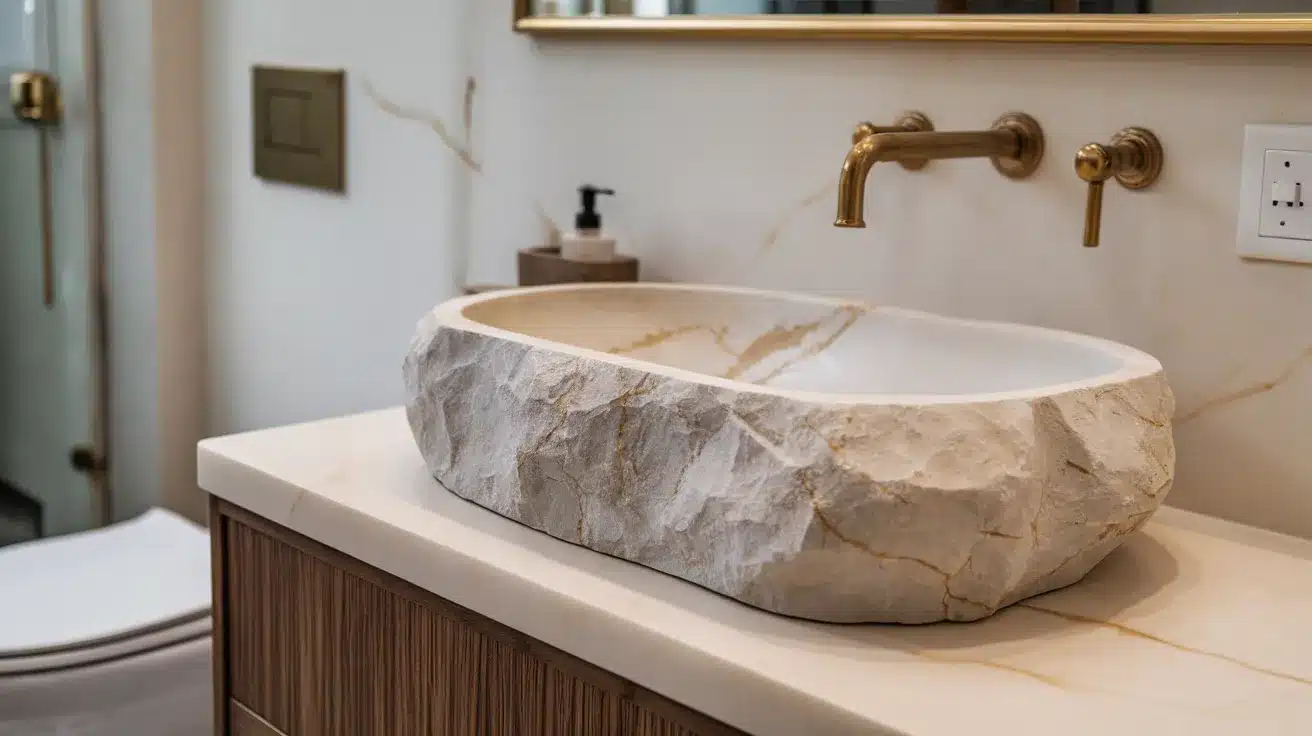
Natural stone sinks bring the outdoors inside with their organic texture and one-of-a-kind patterns.
Made from marble, granite, travertine, or other stones, each sink is completely unique. They add an earthy elegance to any bathroom design and tend to be very heavy and substantial.
| Pros | Cons |
|---|---|
| • Each sink is unique | • Very heavy, requires sturdy support |
| • Extremely durable | • Porous stones need regular sealing |
| • Adds natural texture | • Expensive compared to standard options |
| • Ages beautifully | • Can chip or crack if hit hard |
14. Concrete Sink
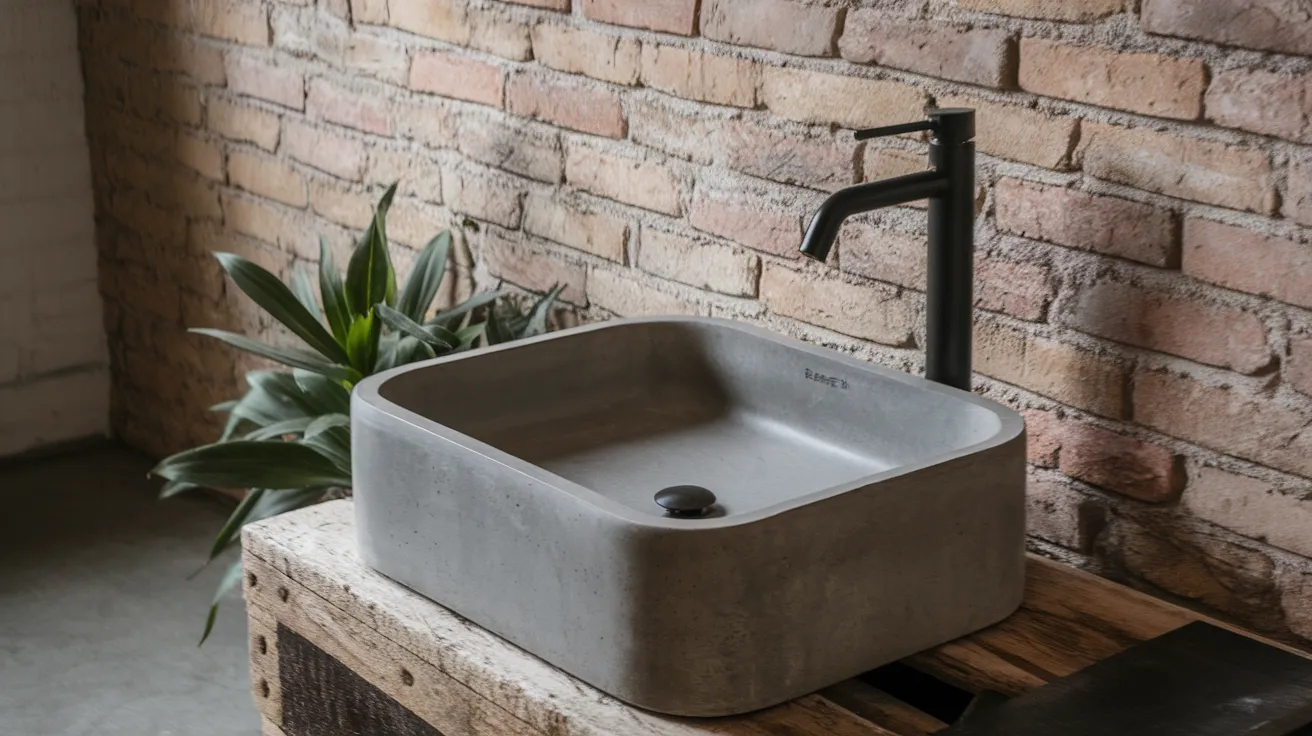
Concrete sinks offer industrial chic with surprising versatility. They can be cast in any shape or size and colored with pigments for customization.
These sinks have a raw, modern appeal that works in contemporary and industrial-style bathrooms. They’re incredibly durable but quite heavy.
| Pros | Cons |
|---|---|
| • Fully customizable shape and size | • Extremely heavy |
| • Very durable | • Requires regular sealing |
| • Unique, modern appearance | • Can develop hairline cracks over time |
| • Can incorporate other materials | • Often requires professional installation |
15. Double Sink
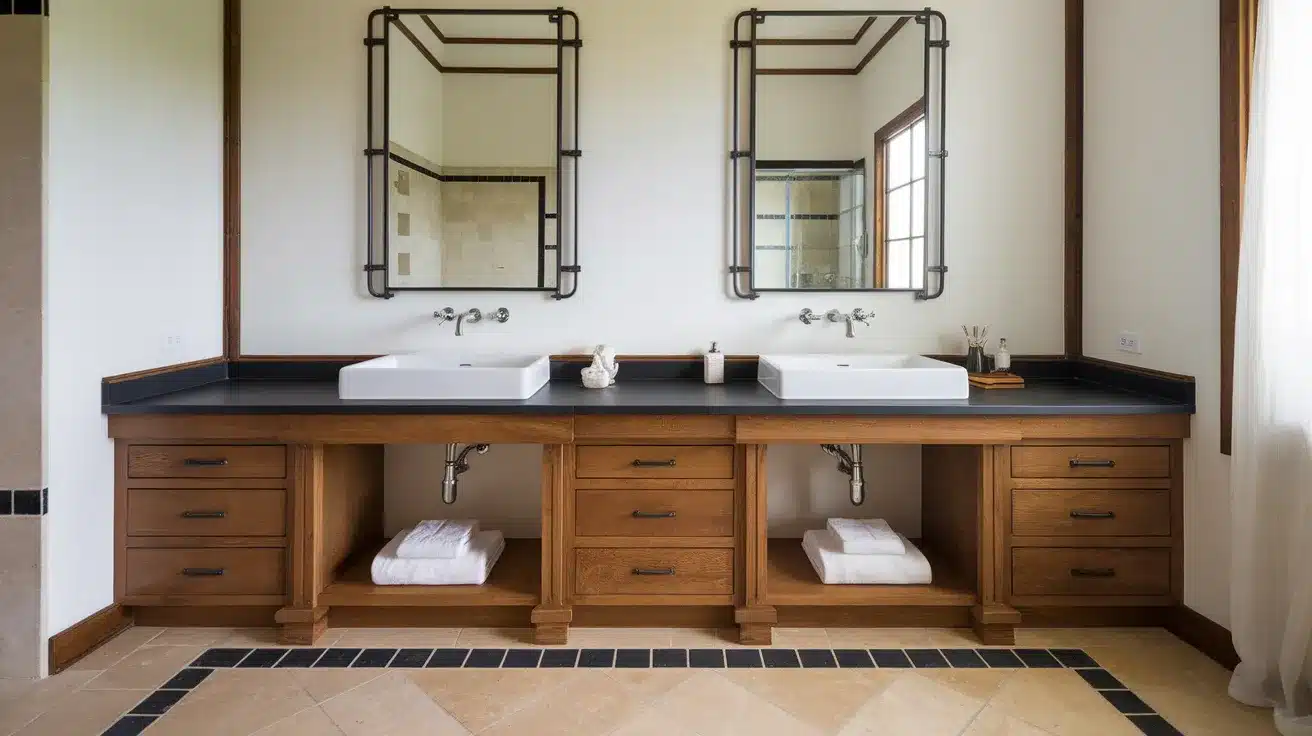
Double sinks feature two separate basins in one vanity. They’re ideal for couples or busy family bathrooms where multiple people need access.
Each person gets their own space, eliminating morning traffic jams. These efficient fixtures come in all the same styles as single sinks.
| Pros | Cons |
|---|---|
| • Eliminates bathroom scheduling conflicts | • Requires more counter space |
| • Each user gets personal space | • More expensive plumbing |
| • Increases home resale value | • Reduces storage space underneath |
| • Efficient for busy households | • Requires a larger bathroom |
16. Farmhouse Sink
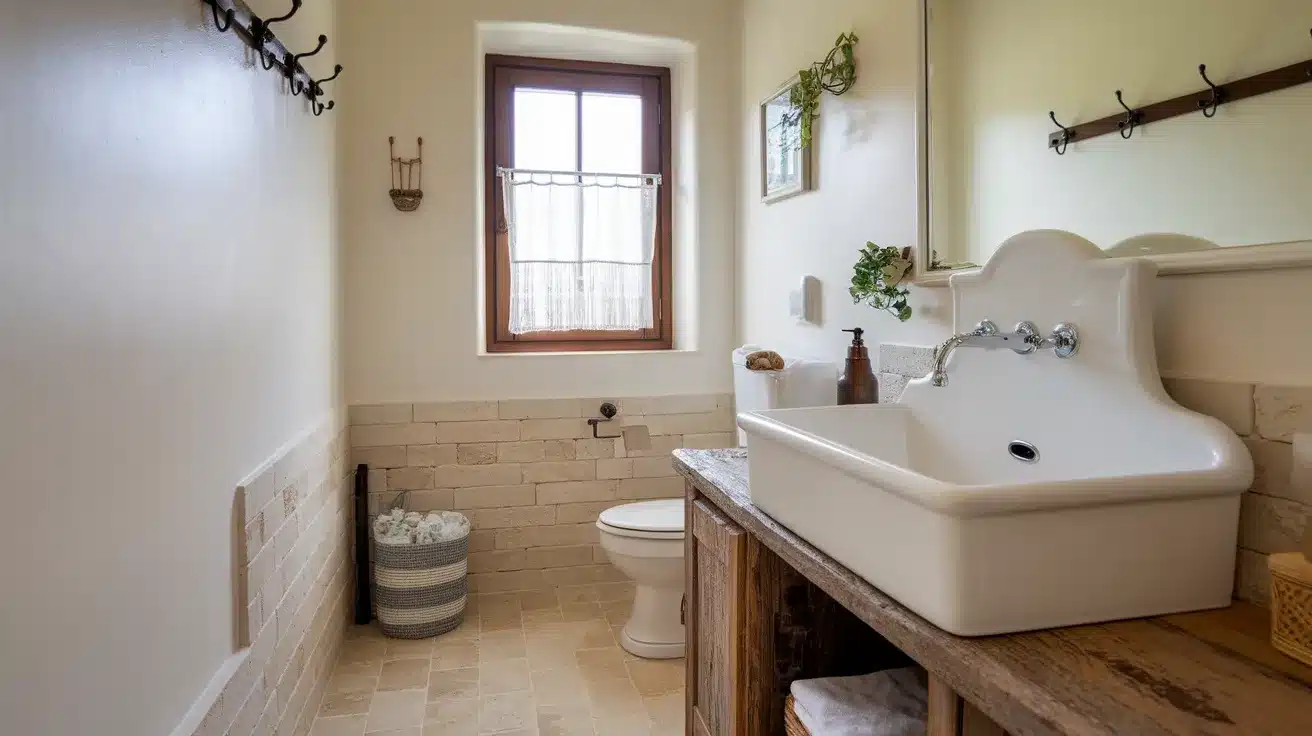
Farmhouse sinks (also called apron sinks) have a large, deep basin with an exposed front panel. While more common in kitchens, they’re gaining popularity in bathrooms for their distinctive look and practical design.
The exposed front creates a dramatic focal point in rustic, country, or traditional bathrooms.
| Pros | Cons |
|---|---|
| • Makes a bold design statement | • Requires special cabinet configuration |
| • The deep basin contains splashes | • More expensive than standard sinks |
| • Easy to access without bending | • Limited counter space |
| • Available in many materials | • Installation usually requires professionals |
17. Semi-Circle Sink
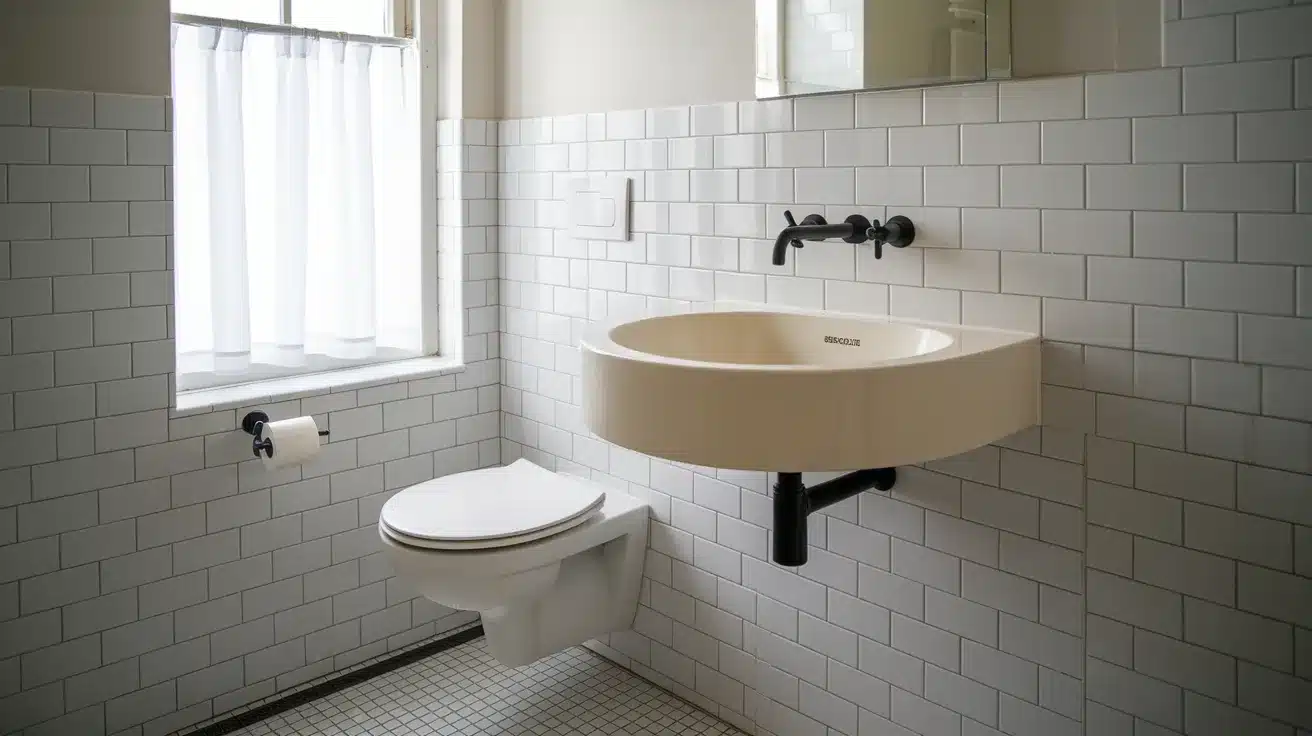
Semi-circle sinks form a half-moon shape that can sit flush against a wall. They maximize space while still providing adequate basin size.
These sinks work well in powder rooms or narrow bathrooms where every inch counts. Their curved front softens the look of a small space.
| Pros | Cons |
|---|---|
| • Space-saving design | • Less basin area than full sinks |
| • Softens room with curved lines | • Limited style options |
| • Can work in tiny spaces | • May splash more due to shape |
| • Often less expensive | • Less counter space |
18. Rectangular Sink
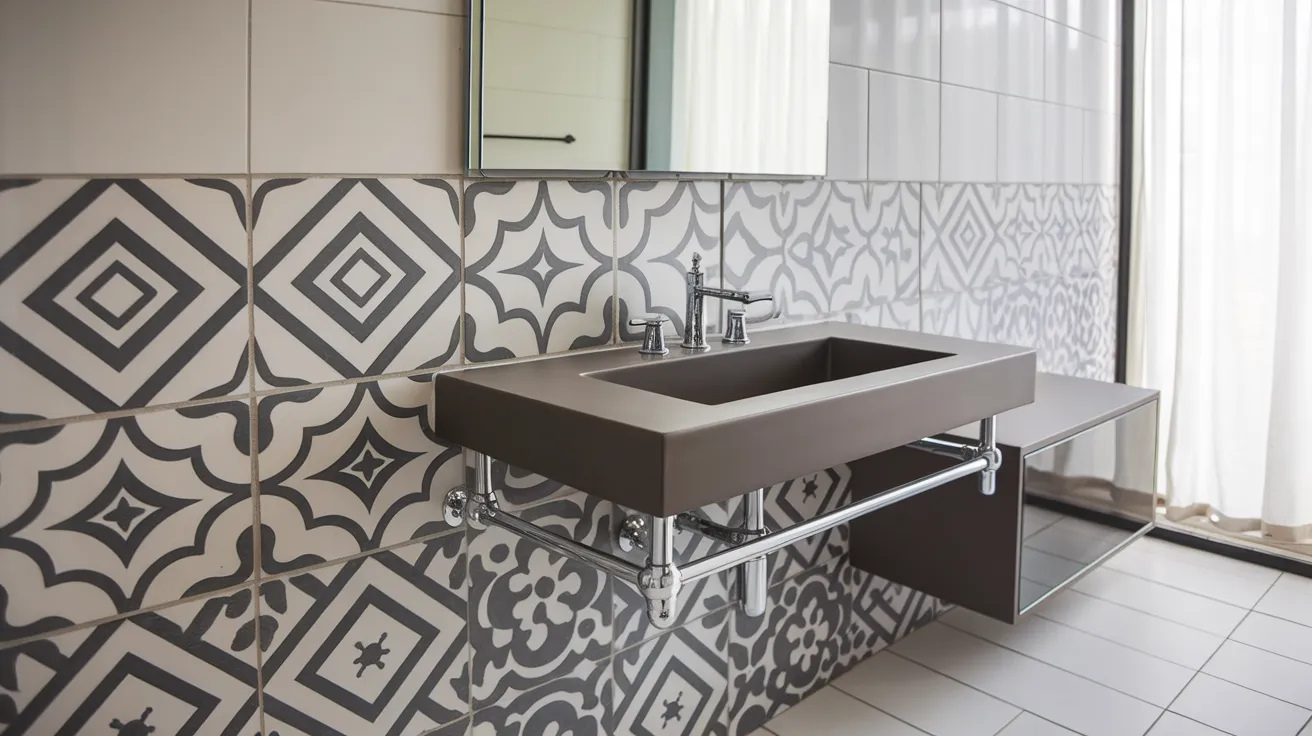
Rectangular sinks offer clean, modern lines that complement contemporary bathrooms. Their straight edges maximize interior basin space and align neatly with vanities.
These geometric sinks come in various materials—porcelain, stone, and glass—and work in undermount, drop-in, or vessel styles.
| Pros | Cons |
|---|---|
| • Maximizes interior basin space | • Corners can be harder to clean |
| • Clean, contemporary appearance | • Can look too stark in traditional settings |
| • Fits neatly with rectangular vanities | • Straight edges show water spots more |
| • Many material options | • Corners can chip more easily |
19. Wash Basin Set
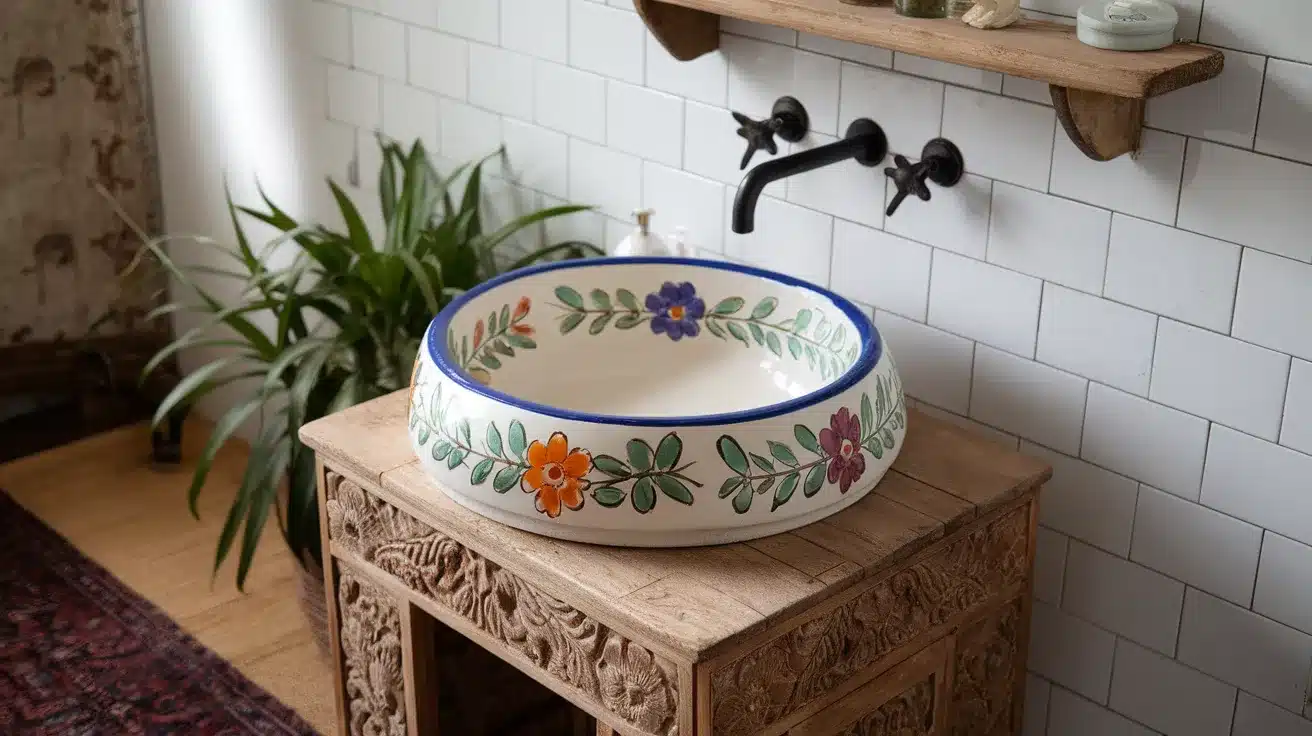
Wash basin sets include a decorative bowl that sits on a matching stand or table.
These artisanal pieces often showcase hand-painted ceramics or carved wood. Popular in bohemian, Mediterranean, or globally-inspired bathrooms, they function as both sink and artwork.
| Pros | Cons |
|---|---|
| • Artistic focal point | • Limited functionality |
| • One-of-a-kind appearance | • Often shallow basins |
| • No installation is required | • Can be unstable if bumped |
| • Can be moved if needed | • May not include overflow protection |
20. Shell Sink
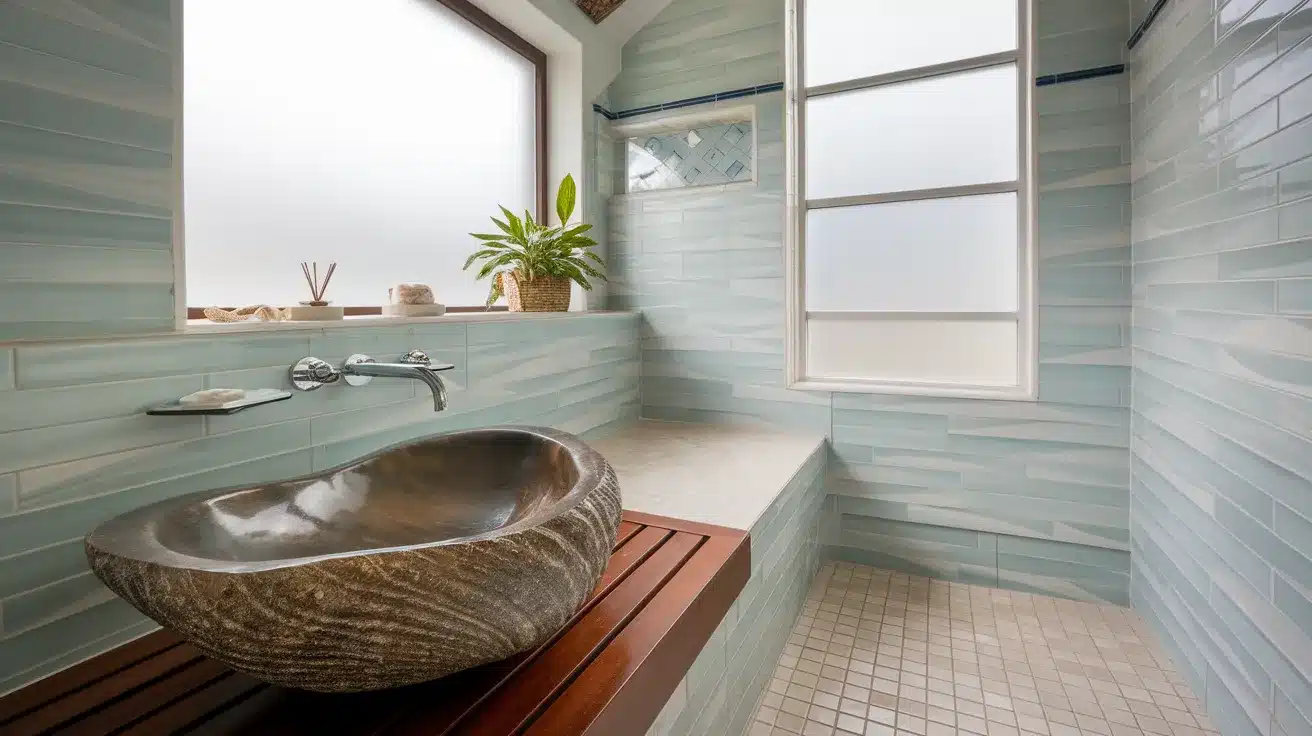
Shell sinks, made from porcelain, stone, or actual polished shells, mimic natural seashells with their organic shapes and rippled textures. They bring a beachy, coastal vibe to your bathroom.
These unique vessel-style sinks instantly create a spa-like or resort-like feeling.
| Pros | Cons |
|---|---|
| • Creates instant coastal theme | • Irregular shape can be hard to clean |
| • Unique conversation piece | • Limited compatibility with faucets |
| • Available in natural or synthetic materials | • May not be practical for everyday use |
| • Creates a resort-like atmosphere | • Can look themed or dated |
21. Metal Sink
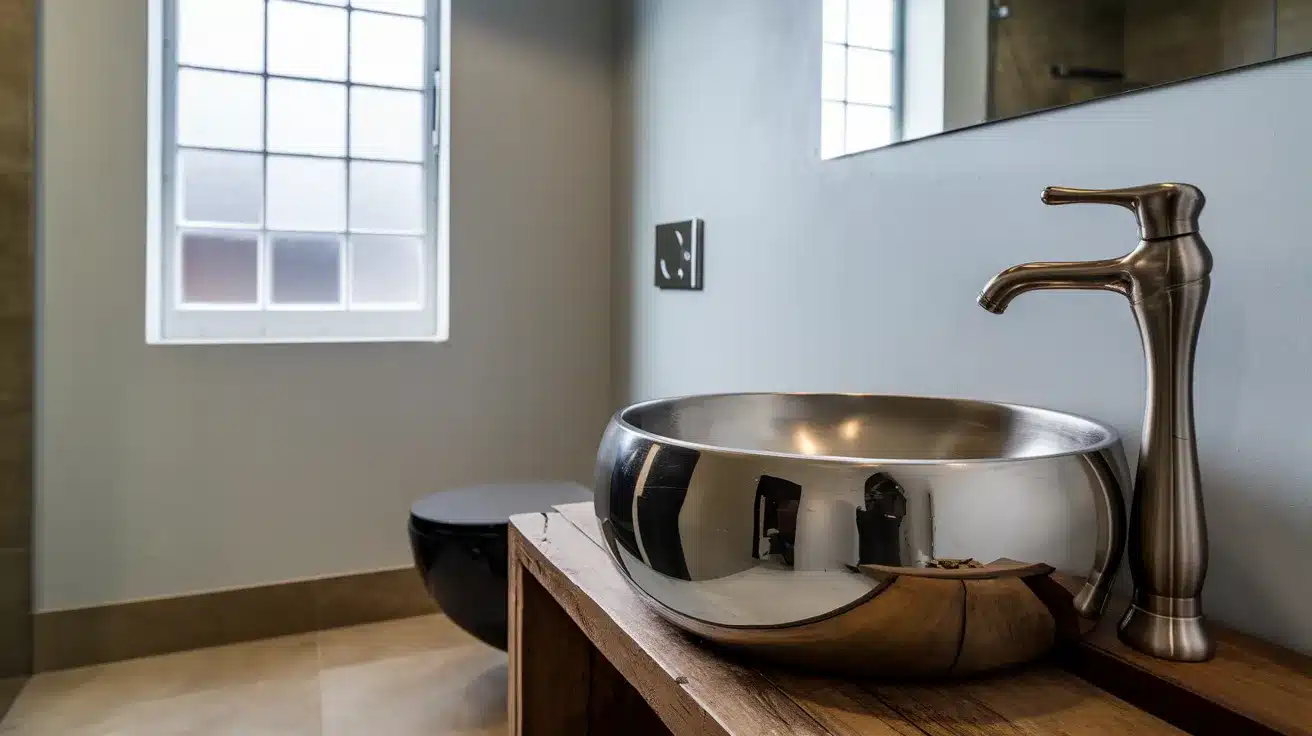
Stainless steel, nickel, and brass sinks offer sleek durability for modern bathrooms. These metal fixtures resist corrosion and withstand heavy use.
Their reflective surfaces bounce light around the room, making smaller spaces feel brighter. They work well in contemporary or industrial designs.
| Pros | Cons |
|---|---|
| • Extremely durable | • Shows water spots and fingerprints |
| • Easy to clean and sanitize | • Can be noisy with running water |
| • Resistant to staining | • Can feel cold to the touch |
| • Contemporary appearance | • Limited color options |
Essential Features of Different Bathroom Sink Types
When renovating or building a bathroom, choosing the right sink is crucial for both functionality and aesthetics. Bathroom sinks come in various styles, each with distinct installation methods, appearance, and practical benefits.
Understanding these differences can help you select the perfect sink for your space, budget, and design preferences.
1. Material Variety
When I shop for bathroom sinks, I always check the material first. You’ll find many options to pick from. Ceramic sinks are common because they’re easy to clean and don’t cost much.
Porcelain looks sleek and comes in many colors. Glass sinks catch the eye but show water spots more. Stone sinks like marble or granite look fancy but need special care. Metal sinks made of stainless steel or copper can last for many years.
Each material has good and bad points. Ceramic might chip over time. The glass needs more cleaning. Stone costs more and can stain if not sealed well.
Metal might scratch or dent. Think about how much time you want to spend on upkeep before you choose.
2. Style
Your sink should match the rest of your bathroom. Do you like clean lines and simple shapes? A modern sink might be right for you. Prefer the look of old farmhouses?
Rustic sinks with wood or stone features could work well. For an industrial feel, try metal sinks with exposed pipes.
I’ve seen many bathrooms where the sink feels out of place. You don’t want that! Pick a style that flows with your other fixtures.
The sink can be the star of the show or blend into the background—it’s up to you and what fits your space best.
3. Space Efficiency
How big is your bathroom? In small spaces, wall-mounted or corner sinks save room. You might want a pedestal sink that takes up less floor space. For tiny powder rooms, I recommend compact vessel sinks.
Large bathrooms give you more choices. Double sinks work great for shared spaces. Wide countertop models offer more space to put things.
The key is to measure your space first. A sink that’s too big makes the room feel cramped. One that’s too small might look odd in a big bathroom.
4. Ease of Installation
Some sinks are much easier to put in than others. Drop-in sinks fit into a hole cut in your counter. Wall-mounted types need strong wall support. Vessel sinks sit on top of counters but need the right drain setup.
I always tell people to think about who will install the sink. If you plan to do it yourself, simpler is better. Some types need a plumber or even a builder. This affects your total cost, too—don’t forget to add this to your budget!
5. Maintenance Needs
Nobody wants to spend hours cleaning their sink. Some types make this job easier than others. Sinks with fewer seams or joints collect less dirt. Smooth surfaces wipe clean faster.
Undermount sinks let you sweep water and dirt right into the drain. But vessel sinks might need cleaning around the base. Materials matter too—glass shows every water spot, while textured stone can hide small marks.
You should ask: How much time can I spend cleaning? If the answer is “not much,” pick a low-maintenance option that still looks good in your space.
How to Choose the Right Bathroom Sink for Your Space?
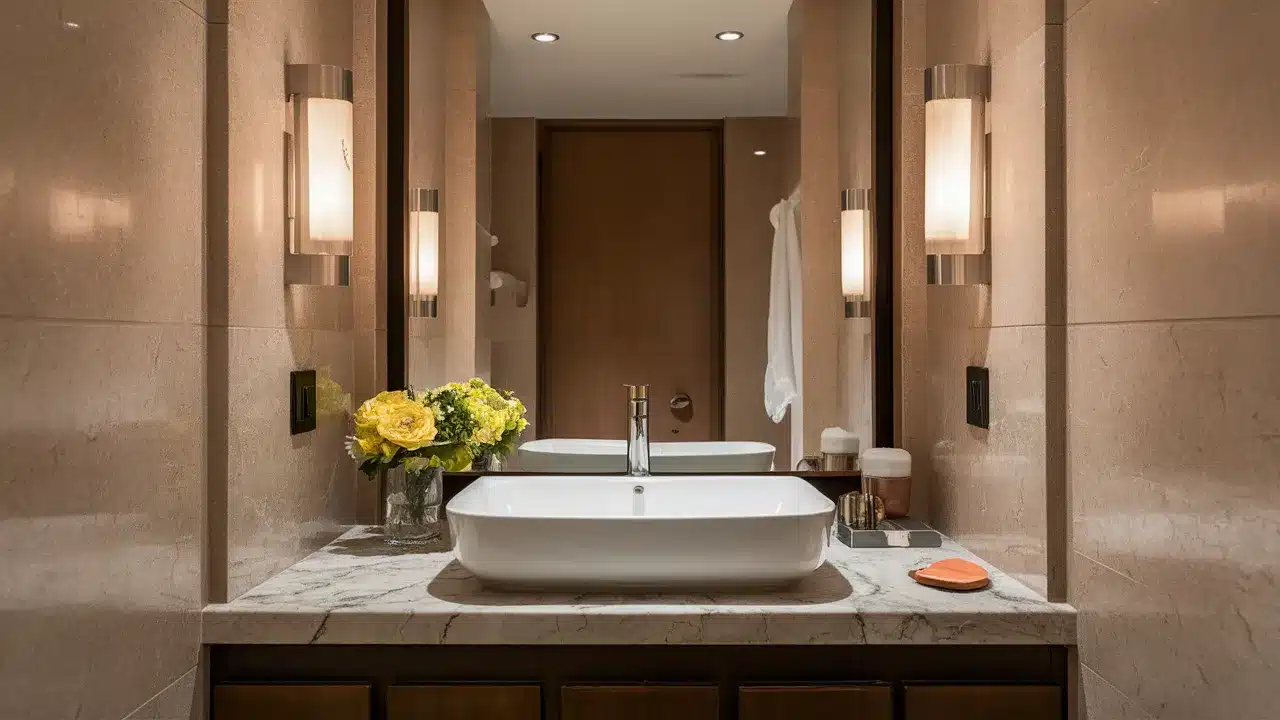
Selecting the perfect bathroom sink might seem like a minor detail in your renovation journey, but it’s a decision that impacts both the functionality and aesthetics of your space daily.
With countless styles, materials, and installation options available, finding your ideal match requires careful consideration of your specific needs and space constraints.
1. Consider Your Bathroom Size
Your bathroom’s size plays a big role in picking the right sink. For small bathrooms, look at corner sinks or wall-mounted options that save space. A compact pedestal sink can work well in tight spots too.
Bigger bathrooms give you more choices. You might go with a large vanity with built-in sinks or even double sinks if you share the space with others. I’ve found that measuring your space first saves a lot of headaches later.
2. Match Sink Type with Your Bathroom Style
The sink should feel like it belongs in your bathroom. A sleek vessel sink fits well in modern bathrooms with clean lines. Old-style bathrooms look better with sinks that have a classic shape.
Think about the other items in your bathroom too. Does your sink need to match your tub? What about your fixtures? The color and shape of your sink can pull your whole bathroom look together.
3. Budget Considerations
Sinks come at all price points. Basic drop-in models can be quite cheap, while custom stone options might cost much more.
Remember to factor in more than just the sink price:
- Faucets are sold separately for most sinks
- Some types need special installation that costs extra
- Certain materials need special cleaners
Set a clear budget before you shop to narrow down your choices.
4. Functionality and Durability
Think about how you’ll use the sink every day. Do you need a deep basin for washing hair? Would a wide, shallow sink work better? Families with kids might want something tough that can handle rough use.
Some materials last longer than others. Porcelain can chip but lasts for years with care. Solid surface materials resist stains but might scratch. Pick what matches your lifestyle and how long you want the sink to last.
5. Long-Term Value
A good sink isn’t just about today—it’s about years from now, too. Will the style still look good in five years? Can parts be replaced if needed?
Some sink types make it easier to update your bathroom later. Others become the focal point that other updates must work around. I always tell people to think ahead when making their choices.
Conclusion
Picking the right bathroom sink makes a big difference in how your bathroom looks and works. As we’ve seen, there are many types to choose from, each with its own good points.
Your perfect sink depends on what matters most to you. Do you need something that saves space? Are you looking for a sink that’s easy to clean? Or maybe you want something that stands out and looks great?
I hope this guide has helped you understand your options better. Remember to think about:
- The size of your bathroom
- Your personal style
- How much you want to spend
Ready to update your bathroom? Take a look at our other bathroom design articles or check out our online sink collection to find the perfect match for your space. Your ideal bathroom sink is just a click away!

